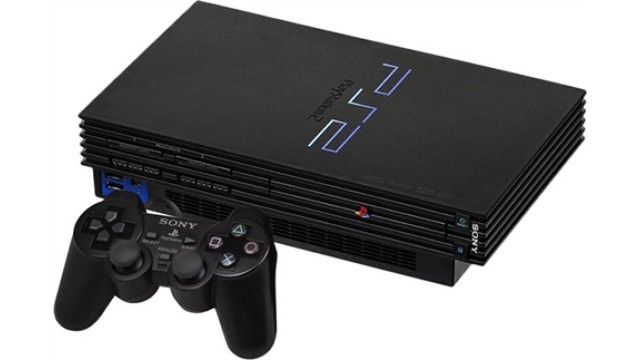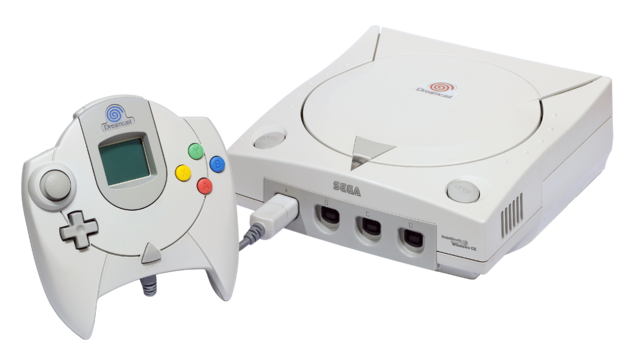
PlayStation 2
Launches: 2000
Discontinued: 2013
Life span: 13 years
Units sold: 160 180 000
Generation: 6th
Country releases of PlayStation 2
 Japan: Japan: | 04/Mar/2000 | 39800 | ¥ |
 USA: USA: | 26/Oct/2000 | 299 | $ |
 United Kingdom: United Kingdom: | 24/Nov/2000 | 299 | £ |
 France: France: | 24/Nov/2000 | 2990 | ₣ |
 Germany: Germany: | 24/Nov/2000 | 869 | DM |
 Spain: Spain: | 24/Nov/2000 | 74900 | ₧ |
 PlayStation 2 technical specifications
PlayStation 2 technical specifications
CPU: Emotion Engine @ 294,912 MHz (128 bits)
Memory: 32 MB
 PlayStation 2 video specifications
PlayStation 2 video specifications
PlayStation 2 graphics capabilities.
Video chip: GraphicsSynthesizer
Video connection: Component Video
 PlayStation 2 audio specifications
PlayStation 2 audio specifications
PlayStation 2 sound capabilities.
Audio chip: SPU1 + SPU2
Audio mode: 5.1
 Controllers of PlayStation 2
Controllers of PlayStation 2
 PlayStation 2 games support
PlayStation 2 games support
Support: DVD
PlayStation 2 games
Games library: 3800
PlayStation 2 story
The PlayStation 2, often abbreviated as PS2, represents one of the most successful and influential video game consoles in the history of gaming. Launched by Sony in 2000, the PS2's development, launch, and market reception are notable for their impact on the gaming industry and the broader entertainment landscape.
The development of the PlayStation 2 was driven by Sony's ambition to build on the success of its original PlayStation, which had established the company as a major player in the console market. By the late 1990s, Sony recognized the need to advance its technology to maintain its competitive edge. The PS2 was designed with several innovative features and improvements over its predecessor. Central to its development was the decision to incorporate a Emotion Engine CPU, which was a powerful 128-bit processor capable of delivering high-quality graphics and processing power. This was complemented by a Graphics Synthesizer GPU, designed to produce impressive visual effects and support complex 3D environments.
Additionally, the PS2 was notable for its inclusion of a DVD drive, a feature that distinguished it from other consoles of its time. This decision was strategic, as it allowed the PS2 to function not only as a gaming machine but also as a home entertainment device capable of playing DVDs. This dual functionality provided a significant value proposition to consumers, offering them an all-in-one solution for both gaming and movie playback.
The development process also involved significant collaboration with third-party developers. Sony worked to ensure that the PS2 would have a strong lineup of games at launch, and its powerful hardware was designed to attract developers who could create innovative and visually stunning titles. This effort was critical in establishing the PS2 as a leading platform for high-quality games.
The launch of the PlayStation 2 on March 4, 2000, in Japan, and later on October 26, 2000, in North America, was a highly anticipated event in the gaming industry. The console's release was supported by an extensive marketing campaign that highlighted its technological advancements and multimedia capabilities. The PS2’s launch lineup included a variety of games designed to showcase its capabilities, such as “Tekken Tag Tournament” and “Ridge Racer V,” which helped to generate excitement and demonstrate the console’s power and versatility.
The launch was met with overwhelming demand, and the PS2 quickly became a hot commodity. Sony’s marketing strategy effectively communicated the console’s advantages, including its advanced graphics, DVD functionality, and broad game library. The PS2’s initial success was bolstered by its ability to offer backward compatibility with original PlayStation games, providing added value to those who already owned a PlayStation and wanted to continue enjoying their existing game library on the new system.
The market reception of the PlayStation 2 was exceptional, solidifying its position as a market leader in the gaming industry. The console's combination of powerful hardware, multimedia capabilities, and a strong lineup of games contributed to its widespread appeal. The PS2’s extensive game library, which eventually grew to include thousands of titles, was a major factor in its success. The console hosted a range of genres and franchises, from action and adventure to RPGs and sports, catering to a diverse audience and maintaining strong sales throughout its lifecycle.
The PS2’s success was also influenced by its ability to attract third-party developers, who produced many critically acclaimed and commercially successful games. Iconic titles such as “Grand Theft Auto III,” “Metal Gear Solid 2: Sons of Liberty,” and “Final Fantasy X” became defining moments for the console and helped to cement its reputation as a leading gaming platform.
The PS2's market dominance was reflected in its sales figures, making it the best-selling video game console of all time. By the end of its lifecycle, the PS2 had sold over 155 million units worldwide, a testament to its widespread popularity and enduring appeal. Its success helped establish Sony’s PlayStation brand as a dominant force in the gaming industry and set a high standard for future consoles.
However, the PS2’s dominance was not without competition. During its lifecycle, the console faced challenges from competitors such as Microsoft’s Xbox and Nintendo’s GameCube. Despite this, the PS2’s strong game library, multimedia capabilities, and established market presence helped it maintain a leading position in the industry.
The PlayStation 2’s development, launch, and market reception illustrate its profound impact on the gaming industry. Its innovative hardware, multimedia features, and extensive game library contributed to its success and solidified its legacy as one of the most influential gaming consoles ever produced. The PS2’s achievements paved the way for future advancements in gaming technology and established a benchmark for success in the video game market.
Previous Sony console: PlayStation
Next Sony console: PlayStation 3


